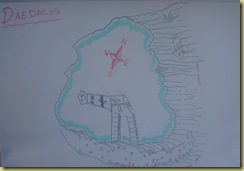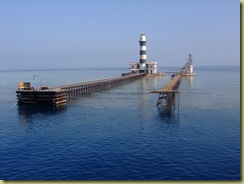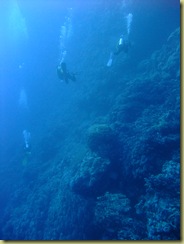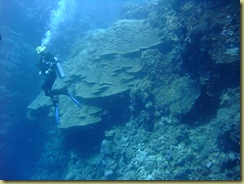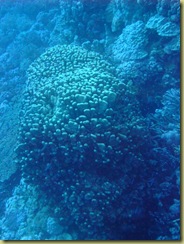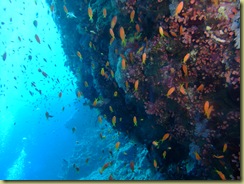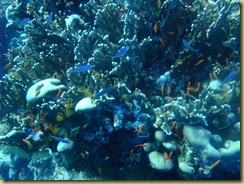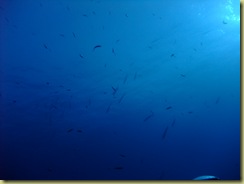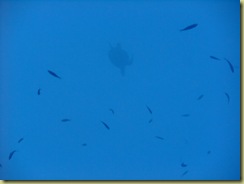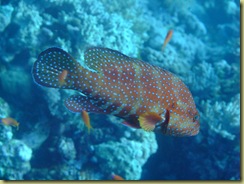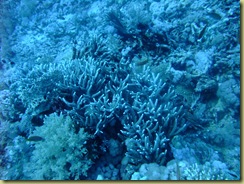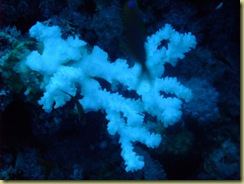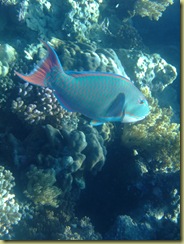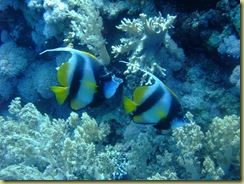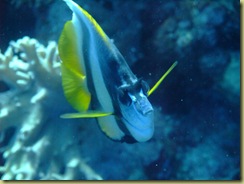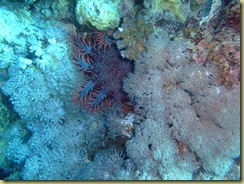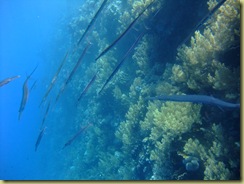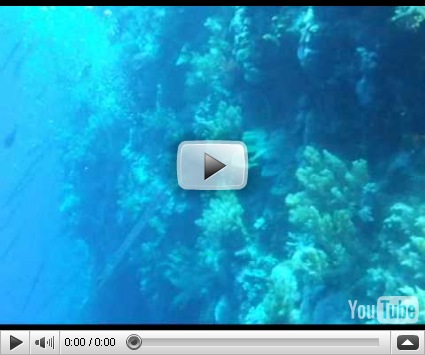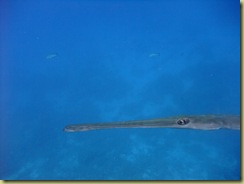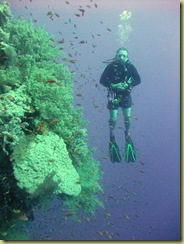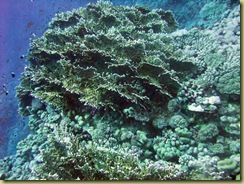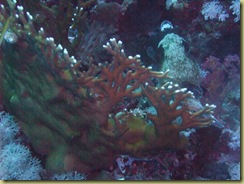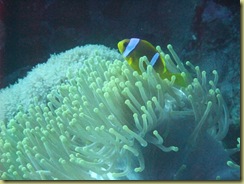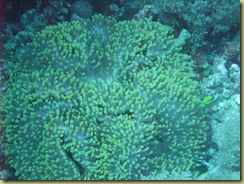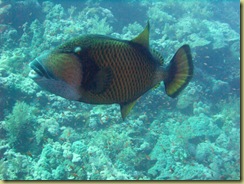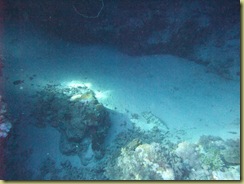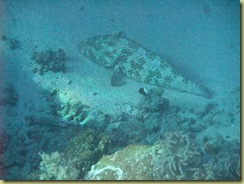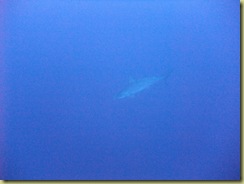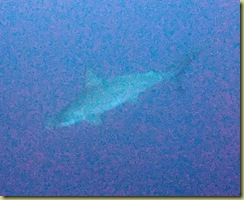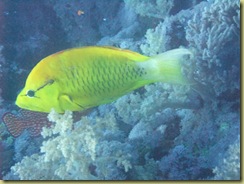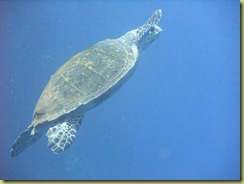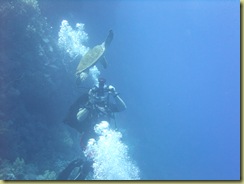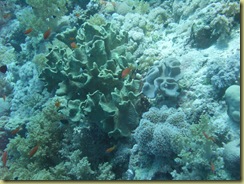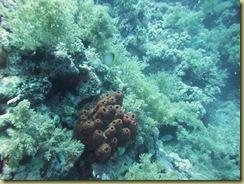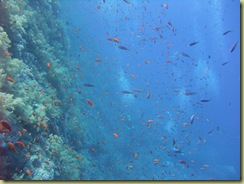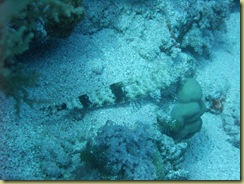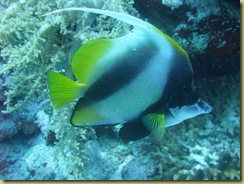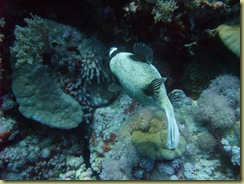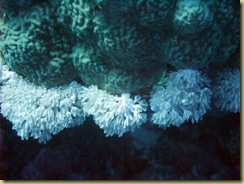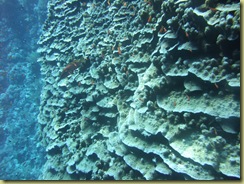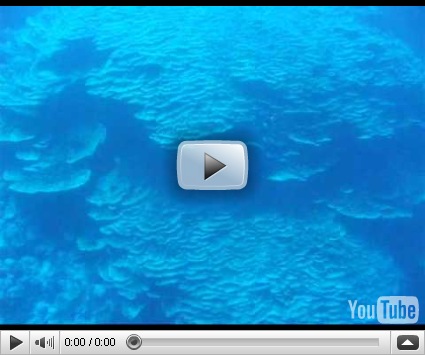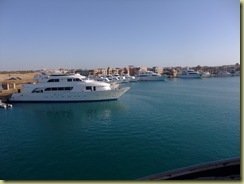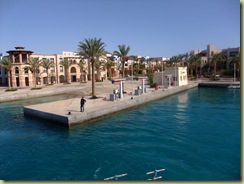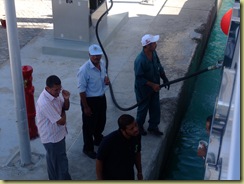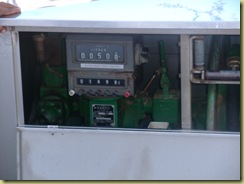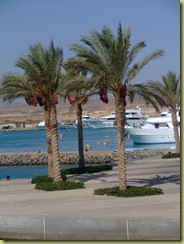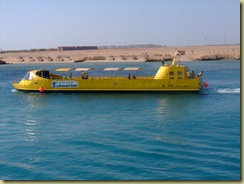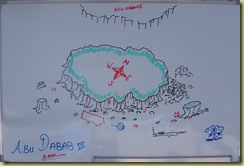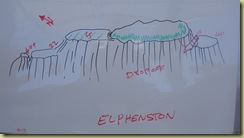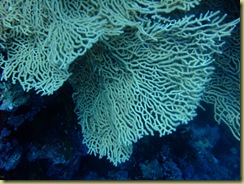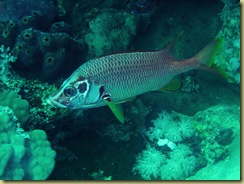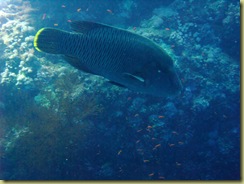Daedalus Reef is 8 hours sailing time down the Red Sea and lies about 70kms off the coast.
It is a large coral outcrop rising shear off the sea bed but despite the expanse of the sea, it has been hit a number of times, hence it has a manned lighthouse to keep it company.
Diving here is complicated because of how much there can be to see and what you have to remember during the dive.
For the technically minded this was a 31% nitrox MOD 33.8m 1.4 pp, rib drop off negative to 7m, then descend to MOD into the blue, current north to south, reef on right shoulder, big loop looking for pelagics in the blue, slow ascent to 5 m along the reef wall, SMBs at 5 m and 3 min safety plus ceilings, surface by 50 bar, rib pickup then breakfast. MDT 60 minutes.
For the non technically minded, divers who dive as often as we are this week often use a special gas mixture called NITROX – normal air contains 21% oxygen, NITROX contains more. However the more Oxygen you breath, the shallower the depth you are allowed to go (because Oxygen is a poisonous gas at depth). Our gas mix is 31% Oxygen (we know that because you personally measure it before each dive) and that creates a depth limit (with a reasonable safety margin) of 33.8m. If you exceed the depth limit slightly, it is no big issue because your dive computer adjusts what you are allowed to do to compensate. If you exceed it by a large amount, it can be a tragedy.
Why do we use a special gas mix? Firstly the more oxygen you breath the less tired you get (and believe me, we get tired), secondly the more oxygen you breath the less nitrogen you breath and nitrogen limits how long you are allowed to spend under water in any 24 hour period. So we are seeking to balance depth with time under water with tiredness with safety and that is why we wear dive computers because they do the complex maths related to depth, time and ascent rates throughout the dive and advise you of what to do. And just to complicate matters further, ordinary air becomes dangerous when you go much below 40 m depth – diving can be complicated!
We are diving as deep as our gas mix will allow (not more than 33.8m) and entering the water from a Rib (rigid inflatable boat) close to the reef. There is the possibility of large fish out in the deeper ocean so we are swimming out there away from the reef whilst remembering that the reef is behind us and as we loop, we are doing so to the right thus keeping the reef on our right shoulder because that way we are finning with the current. Once we get back to the reef, we slowly ascend to 5 metres drifting or finning along and taking as long as possible so we can enjoy the coral and anything else that appears. When our tanks are about 1/3rd full we do a 3 minute safety stop (we stay between 6m and 3 m depth) to allow the nitrogen in our blood stream to escape somewhat and we may be forced to do an additional “ceiling stop” if our dive computer thinks we have exceeded any of the safety limits for the dive. We then deploy our Surface Marker Buoys to show where we are, surface and the rib comes to pick us up and take us back to the boat for a well deserved breakfast. We also have a time limit of about 60 minutes underwater per dive – this is self imposed and is intended to ensure that everyone gets back by a certain time – if you are late, rescue parties are mustered to search for you.
How do we remember to do all of this whilst we are diving? The simple answer is “Training” and because you agree a dive plan with your dive buddy before the dive and keep to it..
Dive 3 – Daedulus Reef from the North East to South East
This dive is all about scale. The reef wall is steep and therefore its drop-off into the ocean is significant as the above picture shows (with divers as the scale marker). Above you can see how
shear the reef wall is.
There are large outcrops of coral attached to the wall
some quite stunning and very old because coral is a slow grower
There are small fish by the million
who seem quite calm as we fin by
plus a lot of fish out in the blue
and a passing turtle some distance away
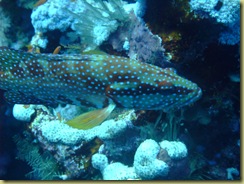
One large Coral Hind was very keen to swim with me
There was of course the common stag horn coral
and some beautiful small corals – colour is different underwater and when you are close up to the coral above, it shines a brilliant white.
Dive 4 – Daedalus Reef from East to South
For this dive we started to the east of the lighthouse (rib drop off again) and drifted and finned with the current back to our boat.
A lot of fish accompanied us as we drifted including the above Napoleon
This Wrasse
and a couple of Trigger Fish who had other things on their mind than divers
Below is a type of Starfish called a “Crown of Thorns” – it is controversial
because many reef preservationists say that it destroys coral reefs by eating the coral (and therefore should be destroyed on sight). Because it has few natural predators, it thrives once established and they cite as evidence of its destructive nature, the damage it has done to the Great Barrier Reef once Abalone numbers (one of its few predators) had been decimated due to over fishing.
Towards the end of the dive we came across a shoal of Cornet Fish
who were very inquisitive – this one came right up to my mask and it was eyeball to eyeball for a number of minutes as we checked each other out.
Dive 5 – Daedalus Reef from West to South West
The objective was to explore a different part of the reef, drifting with the current at an easy depth and just seeing what one could find. A Rib drop off (and pickup) left us at a shear wall of coral with some amazing growths.
If you take the diver in the picture below as a scale, the coral outcrop behind him represents about 1000 years of growth.
This diver is just hanging around besides a crop of fire coral
Fire coral carries with it a red warning colour
because if you touch it, you get stung quite painfully.
Amongst the fish in the coral wall were Nemos such as that above and below which live inside a stinging anemone. Over time, they have developed an immunity to the poison in the anemone and hence nip back inside to hide whenever danger is sensed.
Large Trigger fish such as that below are to be feared because they are very aggressive when defending a nest. Most divers have been chased or bitten by a trigger fish a number of times during their diving careers.
Fish are quite good at camouflage. In a cave on the wall, a large
Grouper was lying quite quietly having a snooze. When it realised we
were there, it opened one eye to keep a watch on us but decided not to move unless it felt threatened (we left it alone and moved on).
Dive 6 – Daedalus reef from the North East to the South East
It was decided by the group that we would stay at Daedalus for an additional day and repeat some of the day’s dives with the hope of seeing the elusive Hammerhead Shark – a few were seen on the first dive here but they were far out into the blue and down deep and so would not really count as a shark spot except to the most desperate.
33% Nitrox, MOD 31.8, current the same as the previous day and so a repeat performance of depth, route and pickup – but:
out of the blue at about 31m depth came a single hammerhead to check us out. At this depth, photography is difficult for simple cameras and therefore the quality of these pictures is not the best.
We had been told to stay together as we went down so that we sounded like a large shoal of fish and therefore possible prey to a group of hammerheads. It is said that they often send one to investigate and report back and here was the “one”.
If the above photographs are adjusted further for colour contrast, the most believing of people can see the peculiar shape of head – I know it was there because it was about 15m away from me.
Mission accomplished!
Dive 7 – Daedalus reef from the South to the South East and back
Giant Stride down to 31m then along the coral wall with a slow ascent to the return point. Lots of interesting fish including a Titan Trigger Fish which
was defending its nest as well as aerating the eggs by fanning water over
them. Woe betide any fish or diver who came near the nest, they were
aggressively chased away and then it would go back to its fanning job. When you see this mouth coming towards you, you quickly back off.
Photographing fish is never easy, they seem to have a knack for turning side on or rearwards just as you take the picture.
It took six attempts to get this fish to pose for me.
Close to the surface was a Turtle which was minding its own business
and it swam around looking for lunch.
one of the problems in being interesting is that you then get followed by all of the paparazzi wanting to take your picture! pursued
There was of course the usual interesting and picturesque coral
Apart from the Trigger Fish, the shoal of Cornets and the Turtle, one of the memories I shall take back from this site is drifting through clouds of Antheas and other small fish
Dive 8 – Daedalus reef from the South to the West
This completes the circuit of the reef, and displays varieties of fish
we have seen before such as the Goatfish above
a Trigger fish who decided to pose for this photograph
a puffer fish who preferred to show us its underneath
a large number of soft corals, including this coral with fish living in it,
and a pom-pom coral whose white is in strong contrast to the green of the brain coral it is growing on. In the current, you see the strands of the coral moving as they take in any passing food
we finished the dive at the enormous Porites Lutea of yesterday. This is about 10m tall which makes it well over 1000 years old and hence one of the oldest animals living on earth – remember corals are animals not plants.
